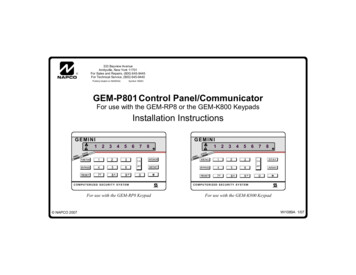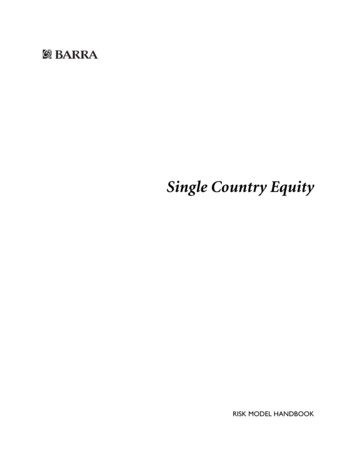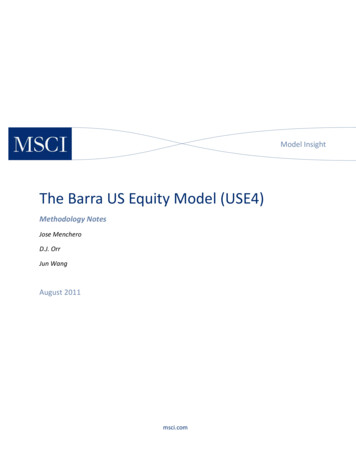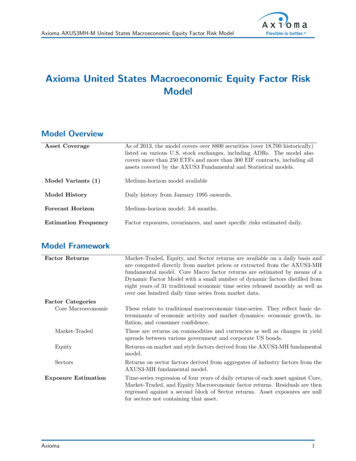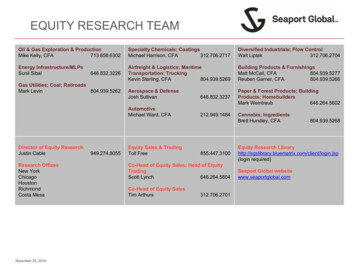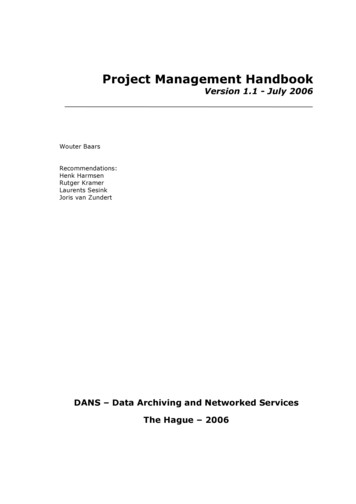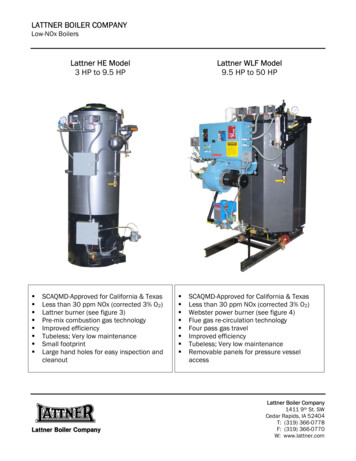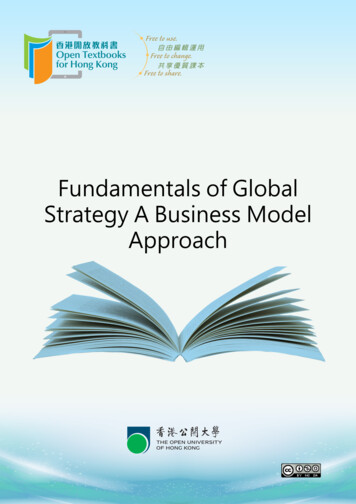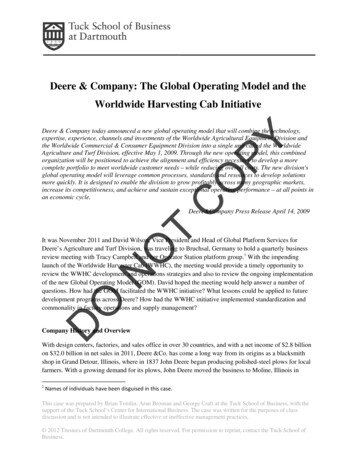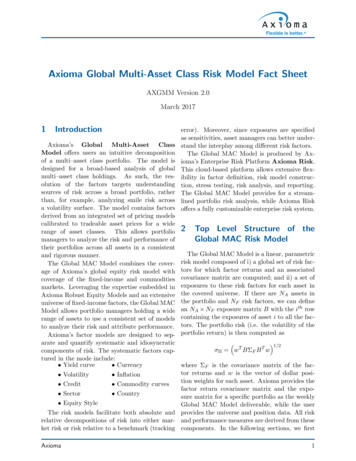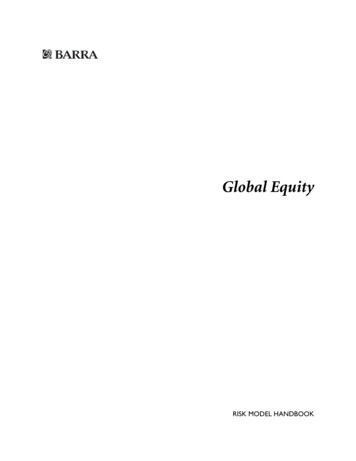
Transcription
Global EquityRISK MODEL HANDBOOK
BARRA makes no warranty, express or implied, regarding the Global Equity Risk Model or any results to be obtained from theuse of the Global Equity Risk Model. BARRA EXPRESSLY DISCLAIMS ALL WARRANTIES, EXPRESS OR IMPLIED, REGARDINGTHE GLOBAL EQUITY RISK MODEL, INCLUDING BUT NOT LIMITED TO ALL IMPLIED WARRANTIES OFMERCHANTABILITY AND FITNESS FOR A PARTICULAR PURPOSE OR USE OR THEIR EQUIVALENTS UNDER THE LAWSOF ANY JURISDICTION. Although BARRA intends to obtain information and data from sources it considers to be reasonablyreliable, the accuracy and completeness of such information and data are not guaranteed and BARRA will not be subject toliability for any errors or omissions therein. Accordingly, such information and data, the Global Equity Risk Model, and theiroutput are not warranted to be free from error. BARRA does not warrant that the Global Equity Risk Model will be free fromunauthorized hidden programs introduced into the Global Equity Risk Model without BARRA's knowledge.Copyright BARRA, Inc. 1998. All rights reserved.0021 O 09/92 RV05/98
ContentsAbout BARRA . . . . . . . . . . . . . . . . . . . . . . . . . . . . . . . . . . . . 1A pioneer in risk management . . . . . . . . . . . . . . . . . . . . . . . . . . . . . 1The Global Equity Model . . . . . . . . . . . . . . . . . . . . . . . . . . . . . . . . . 2Introduction . . . . . . . . . . . . . . . . . . . . . . . . . . . . . . . . . . . . . 3In this handbook. . . . . . . . . . . . . . . . . . . . . . . . . . . . . . . . . . . . . . . . . 3Further references . . . . . . . . . . . . . . . . . . . . . . . . . . . . . . . . . . . . . . . 4Books . . . . . . . . . . . . . . . . . . . . . . . . . . . . . . . . . . . . . . . . . . . . . . . 4Articles . . . . . . . . . . . . . . . . . . . . . . . . . . . . . . . . . . . . . . . . . . . . . 41. Risk and Return . . . . . . . . . . . . . . . . . . . . . . . . . . . . . . . . 5Some definitions . . . . . . . . . . . . . . . . . . . . . . . . . . . . . . . . . . . . . . . . . 5Risk measurement . . . . . . . . . . . . . . . . . . . . . . . . . . . . . . . . . . . . . . . 6Return decomposition . . . . . . . . . . . . . . . . . . . . . . . . . . . . . . . . . . . . 72. The Evolution of Risk Models . . . . . . . . . . . . . . . . . . . . 11Systematic return and diversification . . . . . . . . . . . . . . . . . . . . . . .11The Capital Asset Pricing Model . . . . . . . . . . . . . . . . . . . . . . . . . . 12The Arbitrage Pricing Theory. . . . . . . . . . . . . . . . . . . . . . . . . . . . . 13What are multiple-factor models? . . . . . . . . . . . . . . . . . . . . . . . . . 13How do MFMs work? . . . . . . . . . . . . . . . . . . . . . . . . . . . . . . . . . . . 14Advantages of MFMs . . . . . . . . . . . . . . . . . . . . . . . . . . . . . . . . . . . . 15Model mathematics . . . . . . . . . . . . . . . . . . . . . . . . . . . . . . . . . . . . . 15Risk prediction with MFMs . . . . . . . . . . . . . . . . . . . . . . . . . . . . . . 17i
3.The Global Equity Model . . . . . . . . . . . . . . . . . . . . . . . 21Model development . . . . . . . . . . . . . . . . . . . . . . . . . . . . . . . . . . . . . 21Risk indices . . . . . . . . . . . . . . . . . . . . . . . . . . . . . . . . . . . . . . . . . . . . 22Local markets . . . . . . . . . . . . . . . . . . . . . . . . . . . . . . . . . . . . . . . . . . 23Industries. . . . . . . . . . . . . . . . . . . . . . . . . . . . . . . . . . . . . . . . . . . . . . 26Currencies . . . . . . . . . . . . . . . . . . . . . . . . . . . . . . . . . . . . . . . . . . . . . 284. Model Estimation . . . . . . . . . . . . . . . . . . . . . . . . . . . . . 31An overview . . . . . . . . . . . . . . . . . . . . . . . . . . . . . . . . . . . . . . . . . . . 31Risk index selection and standardization . . . . . . . . . . . . . . . . . . . 34Industry definition . . . . . . . . . . . . . . . . . . . . . . . . . . . . . . . . . . . . . . 35Factor return estimation . . . . . . . . . . . . . . . . . . . . . . . . . . . . . . . . . 35Covariance matrix calculation . . . . . . . . . . . . . . . . . . . . . . . . . . . . 36Exponential weighting . . . . . . . . . . . . . . . . . . . . . . . . . . . . . . . 36Computing market volatility: GARCH models . . . . . . . . . . 37Countries in GEM . . . . . . . . . . . . . . . . . . . . . . . . . . . . . . . . . . . . . . 38Currency risk estimation. . . . . . . . . . . . . . . . . . . . . . . . . . . . . . . . . 39Updating the model . . . . . . . . . . . . . . . . . . . . . . . . . . . . . . . . . . . . . 395. Portfolio Management . . . . . . . . . . . . . . . . . . . . . . . . . 41Portfolio construction . . . . . . . . . . . . . . . . . . . . . . . . . . . . . . . . . . . 41Passive management . . . . . . . . . . . . . . . . . . . . . . . . . . . . . . . . . . . . . 42Active management . . . . . . . . . . . . . . . . . . . . . . . . . . . . . . . . . . . . . 42Model applications . . . . . . . . . . . . . . . . . . . . . . . . . . . . . . . . . . . . . . 446. Global Equity Case Studies . . . . . . . . . . . . . . . . . . . . . . 47Case 1: Analyzing an active portfolio . . . . . . . . . . . . . . . . . . . . . . 47Case 2: Matching the MSEAFE . . . . . . . . . . . . . . . . . . . . . . . . . . . 50Case 3: Creating and optimizing a tilt fund . . . . . . . . . . . . . . . . . 51iiGlobal Equity Model
Appendix A: Risk Index Formulas . . . . . . . . . . . . . . . . . . . . 53Size. . . . . . . . . . . . . . . . . . . . . . . . . . . . . . . . . . . . . . . . . . . . . . . . 53Success . . . . . . . . . . . . . . . . . . . . . . . . . . . . . . . . . . . . . . . . . . . . 53Value . . . . . . . . . . . . . . . . . . . . . . . . . . . . . . . . . . . . . . . . . . . . . . 54Variability in Markets (VIM) . . . . . . . . . . . . . . . . . . . . . . . . . . 55Appendix B: GEM-MSCI Risk Index Factor Returns . . . . . . . 57Appendix C: GEM-MSCI Industry Factor Returns . . . . . . . . 59Appendix D: GEM-MSCI Country Factor Returns . . . . . . . . 73Appendix E: GEM-MSCI Specific Risk Summary . . . . . . . . . 91Appendix F: GEM-FT Risk Index Factor Returns . . . . . . . . . 93Appendix G: GEM-FT Industry Factor Returns . . . . . . . . . . 95Appendix H: GEM-FT Country Factor Returns . . . . . . . . . 109Appendix I: GEM-FT Specific Risk Summary . . . . . . . . . . . 129Glossary . . . . . . . . . . . . . . . . . . . . . . . . . . . . . . . . . . . . . . 131Index . . . . . . . . . . . . . . . . . . . . . . . . . . . . . . . . . . . . . . . . 157Contributors . . . . . . . . . . . . . . . . . . . . . . . . . . . . . . . . . . . 160Contentsiii
ivGlobal Equity Model
About BARRAIn recent years, the international investment environment has experienced major changes: industries are more globalized and local markets are more integrated. The global marketplace includes more andmore players. International portfolios offer global investors opportunities for diversification and the potential for exceptional return.BARRA has responded to this increased institutional interest withthe development of the Global Equity Model.A pioneer in risk managementAs the leading provider of global investment decision tools, BARRAprovides quantitative products and services for global investmentmanagers and financial institutions. Since our founding in 1975,BARRA has been a leader in modern financial research and techniques.Initially, our services focused on risk analysis in equity markets. OurU.S. Equity Model set a standard of accuracy that BARRA continuesto follow. BARRA uses the best risk predictors available to developrisk prediction models. In turn, these models are the basis of software products designed to enhance portfolio performance throughrisk analysis, portfolio optimization, returns forecasting, transactioncost analysis, and historical performance attribution.In 1979 BARRA expanded into the fixed income area with therelease of our bond valuation and risk models. In the late 1980sBARRA developed the Global Equity Model (GEM), designed toanalyze international portfolios of equity and currency holdings.BARRA offices are located in all major financial regions. By 1998 ourclients comprised over 1200 financial institutions worldwide whorely on BARRA’s investment technology and consulting services tostrengthen their financial analysis and investment decision-making.1
The Global Equity ModelAs BARRA has expanded internationally, we have developed equitymodels for the major asset markets throughout the world. Initiallyreleased in January 1989, BARRA’s Global Equity Model extends theconceptual principles of its single-country counterparts to the international equity market.A multiple-factor model, GEM captures the effects of common factors (such as local markets and industries) as well as currencies onportfolio return. The model partitions return into its various components so investors can pinpoint sources of return and adjust theirportfolios accordingly.There are two versions of GEM—MSCI and FT. The MSCI versionuses the local markets and industry classifications of the MorganStanley Capital International World Index while the FT version useslocal markets and industries listed in the Financial Times-ActuariesWorld Index.BARRA delivers the Global Equity Model via the Windows-basedAegis System . Applications within Aegis include risk analysis andportfolio optimization, to allow BARRA clients to make betterinvestment choices.2Global Equity Model
IntroductionIn this handbookThis handbook first outlines the theoretical background of theGlobal Equity Model and then describes the model in greater detail.It is designed to be a technical reference manual for the model.A discussion of risk and return is the starting point for explainingthe model and its capabilities. Chapter 1. Risk and Return definesimportant measures of risk and outlines the decomposition ofreturn.Multiple-factor models represent a breakthrough in financial theoryand provide a framework for understanding GEM. Chapter 2. TheEvolution of Risk Models catalogues the theoretical advances leadingto the development of multiple-factor models and explains howthese models work.BARRA risk models are multiple-factor models that are developedfor particular asset markets. Chapter 3. The Global Equity Model liststhe common factors and currencies of GEM-MSCI and GEM-FTand includes examples of common factor correlations.To help you further understand the technical and analytical foundation of the model, Chapter 4. Model Estimation explains the estimation procedure used in deriving the model. The chapter describesrisk formulation, industry definition, local market selection, and currency risk estimation.Chapter 5. Portfolio Management covers portfolio construction, aswell as passive and active management techniques. In addition, BARRA’s GEM software applications and their uses are discussed.Finally, Chapter 6. Global Equity Case Studies includes three casestudies to illustrate how the model can enhance your financial decision making. The first analyzes an active portfolio, while the secondindexes a passive one. The third describes an example of index optimization.For more background on the output of the model, the Appendicesinclude risk index formulas, factor return plots, and other information. In addition, the Glossary is a useful resource for clarifying terminology and concepts.3
Further referencesBARRA has a comprehensive collection of articles and other materials describing the models and their applications. To learn more aboutthe topics contained in this handbook, consult the following references or our extensive BARRA Publications Bibliography, all availablefrom BARRA offices and from our Web site at:http://www.barra.com.BooksRichard C. Grinold and Ronald N. Kahn, Active Portfolio Management: Quantitative Theory and Applications, Probus Publishing, Chicago, IL, 1995.Andrew Rudd and Henry K. Clasing, Modern Portfolio Theory:The Principles of Investment Management, Orinda, CA, Andrew Rudd,1988.ArticlesRichard Grinold, Andrew Rudd, and Dan Stefek, “Global Factors:Fact or Fiction?” Journal of Portfolio Management , Fall 1989,pp. 79–88.Barr Rosenberg, “Extra-Market Components of Covariance inSecurities Markets,” Journal of Financial and Quantitative Analysis,March 1974, pp. 263–274.Barr Rosenberg, Kenneth Reid, and Ron Lanstein, “PersuasiveEvidence of Market Inefficiency,” Journal of Portfolio Management ,Spring 1985, pp. 9–16.Andrew Rudd and Barr Rosenberg, “Realistic Portfolio Optimization,” TIMS Studies in Management Sciences, Volume 11, 1979,pp. 21–46.4Global Equity Model
1. Risk and ReturnThe concepts of risk and return are central to a discussion of financial investment. They illustrate the major tension faced by investors:in exchange for bearing risk, investors require a higher return. Infinancial parlance, this is called the risk/return tradeoff and investorschoose a risk/return combination based on their attitudes towardrisk.Some definitionsIn an uncertain investment environment, investors bear risk. Risk isdefined as the total dispersion or volatility of returns on a security orportfolio. Furthermore, risk reflects uncertainty about the future.Conventional notions of risk are negative, describing outcomes thatare less than desirable. However, in investment circles, risk measuresmore than negative outcomes. It describes outcome probability inboth directions—positive and negative—as well as the magnitude ofuncertainty. This is a small but significant distinction. Appropriaterisk levels and “best” investments are in the eyes of the investor anddepend on several investor characteristics, most notably total wealthand risk preferences.Return is the reward to owning an investment. Return includes payments received in cash (dividends) and changes in the value of aninvestment (capital gains or losses). Simply stated, return is the riskpremium earned by a security or a portfolio—the excess return—plusthe risk-free rate
U.S. Equity Model set a standard of accuracy that BARRA continues to follow. BARRA uses the best risk predictors available to develop risk prediction models. In turn, these models are the basis of soft-ware products designed to enhance portfolio performance through risk analysis, portfolio optimization, returns forecasting, transactionFile Size: 1MBPage Count: 166
